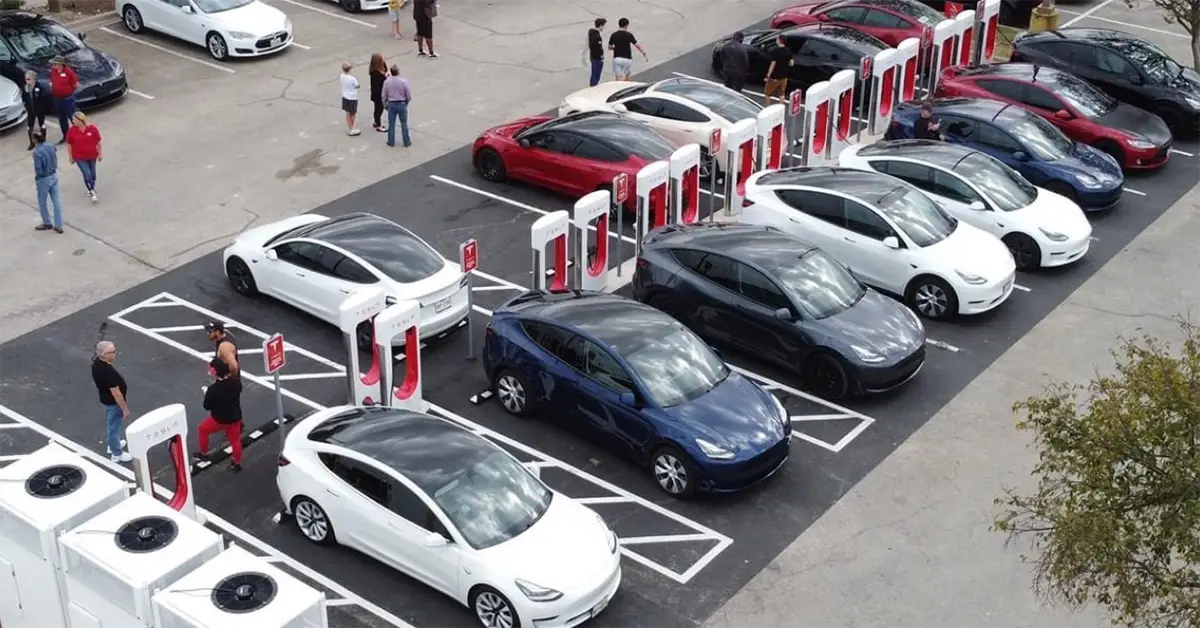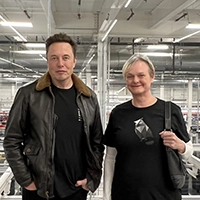The Future of Electric Vehicle Infrastructure
07/13/2023 / Gail Alfar
All vehicles, electric or gasoline, depend on infrastructure to operate. Having previously owned eight different combustion vehicles and currently owning two electric vehicles, I've experienced both types of infrastructures.
In this article, I’ll discuss my experiences and look at what the future holds for us as we enter into a new era of all-electric vehicles that will require a robust electric charging network and an economy powered by sustainable energy, as well as discuss the transition from traditional to electric vehicle infrastructure.
Origins of Automotive Infrastructure for Gasoline Cars
image credit: user jjlew080 on Reddit
The first gas station, designed specifically for dispensing gasoline to motor vehicles, was opened in 1905 by the Standard Oil Company in St. Louis, Missouri. It was a simple structure with a canopy. Prior to this, gasoline was sold at pharmacies, general stores, and even through roadside pumps. Electric car infrastructure was also being built, and in 1910, Chicago, Philadelphia, Cleveland, New York, and Baltimore all had electric charging stations. Electric vehicles did not survive the first round of mass vehicle adoption. Early electrification of vehicles gave way to a massive oil and gas economy.
The world’s current gas station network must rely on an aging oil refining and distribution system. The infrastructure supporting combustion vehicles is nearing an end. That said, it is still necessary, and our current economy would be paralyzed without it.
In a conversation with astrophysicist Neil deGrasse Tyson, Elon Musk explained why our world needs to transition to sustainable energy:
"If we don't find a solution to burning oil for transport, when we then run out of oil, the economy will collapse and society will come to an end. If we know we have to get off oil no matter what, we know that is an inescapable outcome, why run this crazy experiment of changing the chemical composition of the atmosphere and oceans by adding enormous amounts of CO2 that have been buried since the Precambrian Era? That's crazy. That's the dumbest experiment in history, by far."
Success for Today’s EV Infrastructure
Electric car battery charging infrastructure and the associated technology needs to be easy to use to be a success. Tesla introduced the North American Charging Standard (NACS) in 2022, which is a charger connector that is ergonomic, light, and simple.
When an EV is manufactured, it can include the NACS connector in the charging port of the vehicle. In the USA, you will find this connector in all Tesla vehicles, and by 2024, many other EVs will be built with the NACS connector, including Ford, GM, Mercedes-Benz, Rivian, and Polestar.
Ford is the First to Announce it will Adopt the NACS
In May 2023, it hit the news that Tesla Supercharger sites will welcome other electric vehicle manufacturers. This means it will be very easy for more auto companies to sell electric vehicles because they can Supercharge almost anywhere.
The first carmaker to announce they will make their trucks and cars with the NACS was Ford on May 25, 2023. Jim Farley, CEO of Ford, said:
“To accelerate EV adoption and make the transition successful for our customers, we must improve the charging infrastructure. Excited to work with Elon Musk and Tesla to give our Ford EV owners access to the Tesla charging network. Details here:https://bit.ly/3oqPsiS”
General Motors becomes the second automaker to adopt the NACS
After listening to a live conversation with Jim Farley and Elon Musk, I was invited to listen to another live talk with Mary Barra, CEO of General Motors, and Elon Musk on June 8, 2023.
A video release from GM explains that the company is excited about its partnership with Tesla and that it will mean that customers and the industry will move faster towards adopting EVs. GM announced, “We want to bring #EverybodyIn to the all-electric future, and cross-industry collaboration is essential to that goal.”
Here’s the 30 second video from GE that outlines the charging infrastructure.
Excited for what this partnership means for our customers and the industry. https://t.co/3qlkVvW7kR
— Mary Barra (@mtbarra) June 8, 2023
Rivian adopts the NACS
On June 20, 2023, the EV world celebrated that Rivian, maker of electric trucks, would adopt the NACS. Here’s what Rivian had to say,
“Today we signed an agreement with Tesla to adopt the North American Charging Standard. This opens charging for Rivian vehicles on Tesla's Supercharger network across the United States and Canada. Access starts as soon as Spring 2024.”
Have you seen the beautiful Rivian pickup truck? You can check out the cost for a loan or lease for one on the Xcelerate website. In fact, Xcelerate will accommodate your needs for any EV you would like to buy or lease.
Polestar EVs will be equipped with the NACS
On June 29, 2023 Polestar stated “From 2025, new Polestar vehicles sold in North America will be equipped with the NACS charging port by default. Adapters to help allow existing Polestar drivers to access the network in a convenient way are expected in mid-2024.”
Mercedes-Benz becomes the first German automaker to implement NACS
A press release by Mercedes-Benz from July 7, 2023 states,
"Mercedes-Benz will be the first German OEM to implement NACS ports into its new electric vehicles starting in 2025. As part of a phased transition, Mercedes-Benz will initially offer an adapter that enables the company’s existing CCS BEVs to charge seamlessly on the NACS network from 2024 onwards."
Superchargers
I am personally delighted with how fast the Tesla Supercharger Network has grown since I first purchased my Model 3 in December 2019. Tesla builds Superchargers fast and strategically locates them in places where their power is most needed.
Superchargers Are Installed Fast and Efficiently
In order to meet the consumer demand for EV charging and accelerate the transition to all-electric vehicles, Tesla makes Prefabricated Supercharger Units (PSUs) with the NACS at their Gigafactory in New York. These contain all of the required charging equipment and connections and can be installed in a few days. Tesla says on their Twitter account,
“PSUs are fully assembled Supercharger sites—they come with stalls mounted on a concrete slab & electrical components prepared for grid connectivity This helps us to get new sites up & running significantly faster—enabling construction to be completed within days, not weeks.”
Giga New York is the new home of Prefabricated Supercharger Units (PSUs) pic.twitter.com/Yi41Tv1iVn
— Tesla (@Tesla) March 15, 2023
Supercharger Locations
Superchargers are located in many places along major highways, including at most Buc-ee’s Country Stores. This is how Buc-ee’s is described: “Buc-ee's is an American chain of country stores, gas stations, and electric vehicle chargers created and owned by Arch Beaver Aplin III, headquartered in Lake Jackson, Texas.”
Does it come as a surprise to you that Buc-ee’s wants Tesla Supercharger sites at its many locations? It is great for business, so I’m not surprised. When I Supercharge at Buc-ee’s to extend my range, I also buy food and souvenirs and use their famous bathrooms, just like people who stop there to buy gas. In this way, Buc-ee’s is making a smart business decision as more people make the switch to lower maintenance and lower cost-per-trip EVs.
Instead of cumbersome and polluting tank trucks that you see filling the underground tanks at gas stations, a Tesla charging station depends on renewable energy from solar or wind-generated electricity. With Tesla charging, you drive up to the Supercharger, plug in, and relax. There is no need to pull out a credit card, and there is no digital screen to worry about. If you want to monitor the charging, you’ll do that on the Tesla App or on the screen inside your car. As mentioned in this article, you will pay a lower rate per kWh if you Supercharge during low usage hours.
Home and Destination EV Charging
My experience with the current EV infrastructure built by Tesla has been wonderful. I use Superchargers when driving long distances, and I use home charging at night. Home and destination charging are similar in that the rate of charging is slower. When I charge at a slower rate, it is convenient to charge at night when utility rates are low and wake up in the morning to a fully charged vehicle. You can install slow chargers at your home and find them at apartment complexes, workplace parking, hotels, and campgrounds. Soon you’ll be able to slow charge near the Xcelerate headquarters in McKinney, Texas, while seeing the historic downtown!
Electric Vehicle Service Centers
The support infrastructure for electric vehicles is easier to build and maintain than that for gasoline cars. For instance, in Austin, where I live, there are 3 Tesla Service Centers, one Tesla body shop, and many Tesla mobile service technicians who come to my work or home for repairs. Currently, a 4th Service Center is in planning. I share this information with you because Service Centers are part of the future of electric vehicle infrastructure, and you likely have a Tesla Service Center in the largest metro area near you.
Planning Your Electric Future
Before you purchase or lease an electric vehicle, look into the electric vehicle infrastructure in your city. If you make frequent long-distance trips, identify where you will charge your vehicle prior to purchasing it.
You can be a part of the electric vehicle revolution, help curb CO2 emissions, and enjoy the fast speed and lower maintenance cost of an EV as new infrastructure is built every day and expanding rapidly. You are going to want to make your next car electric, and if you have a second vehicle in your family, you’ll likely prefer that one to be electric too."
Posted in
Tagged




